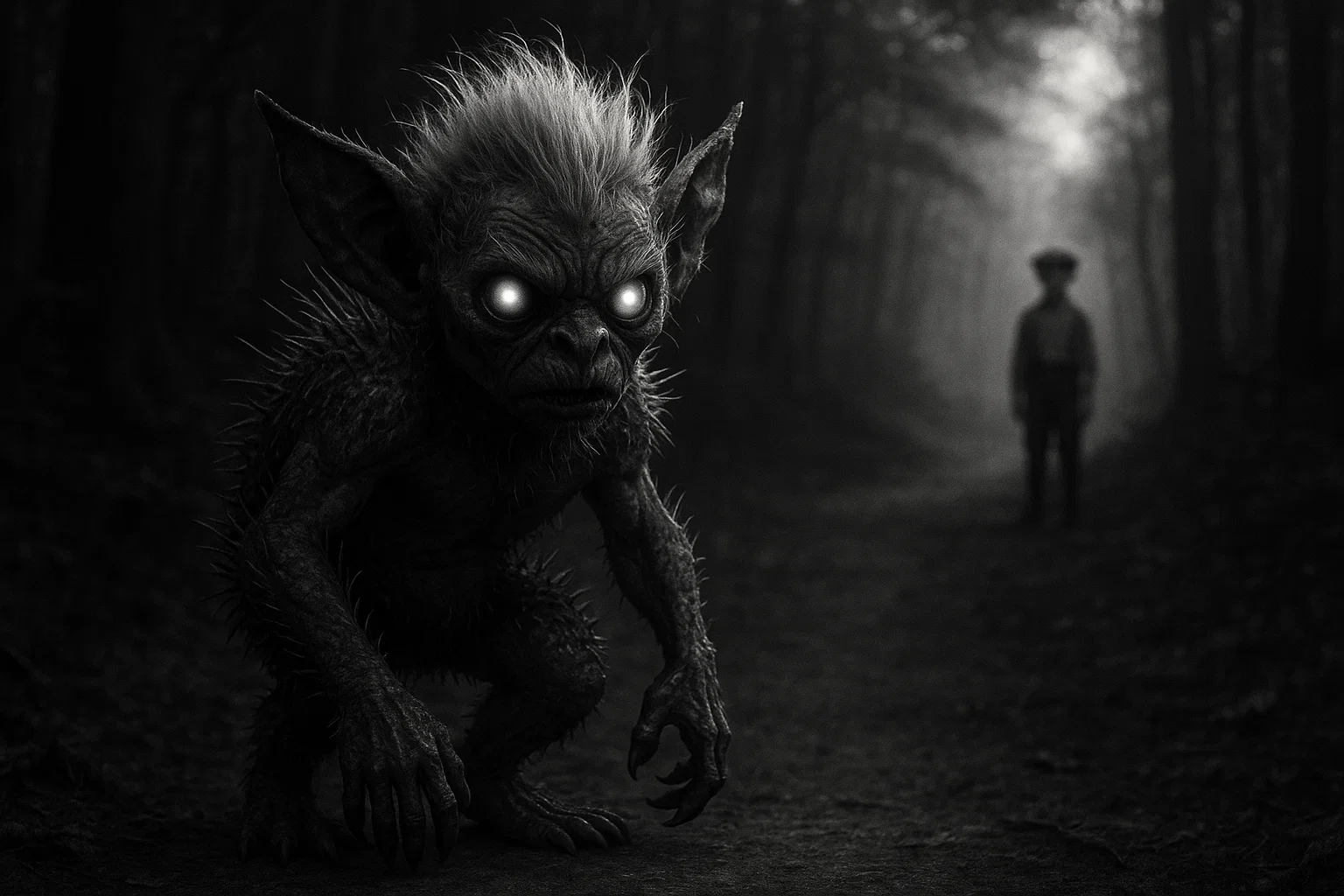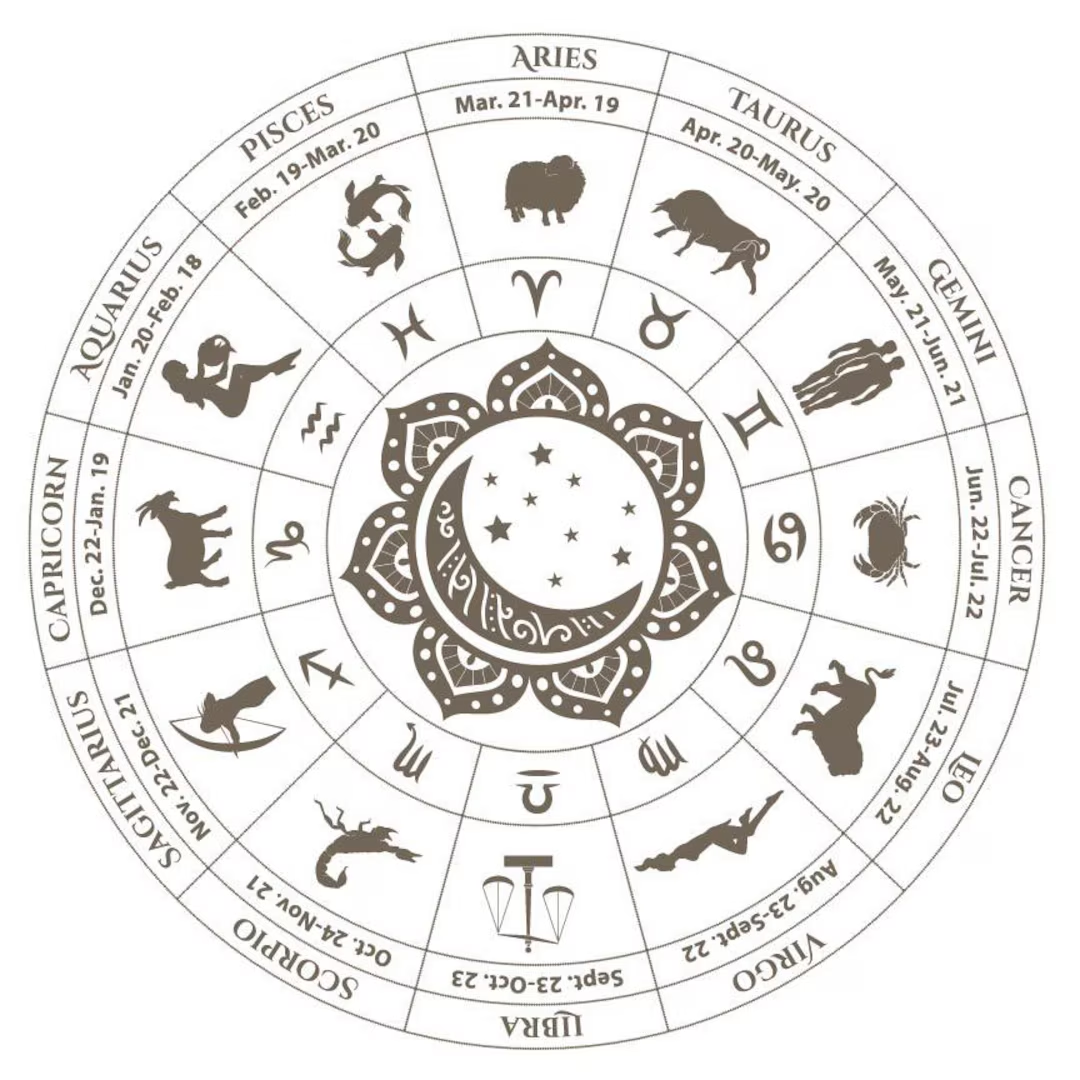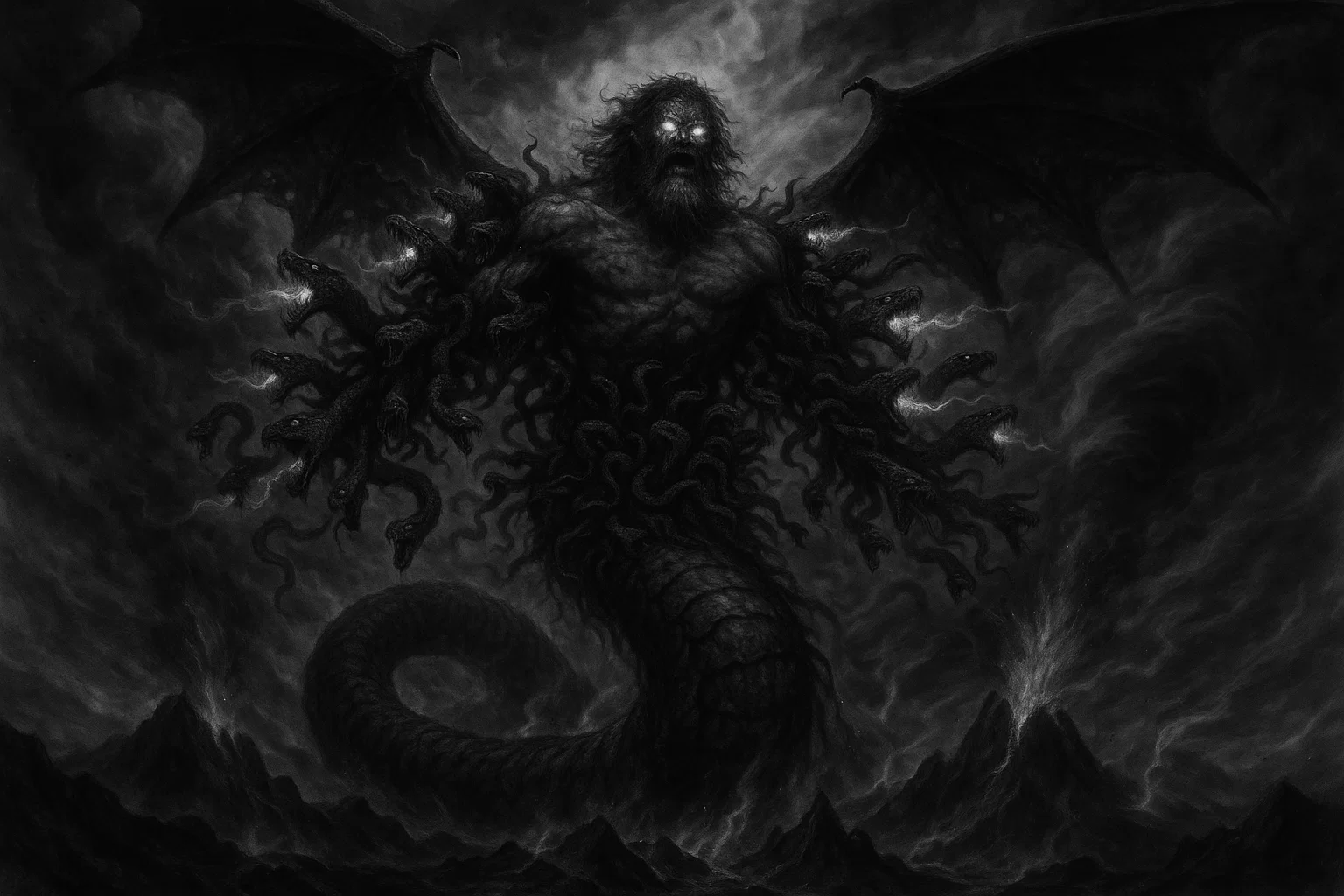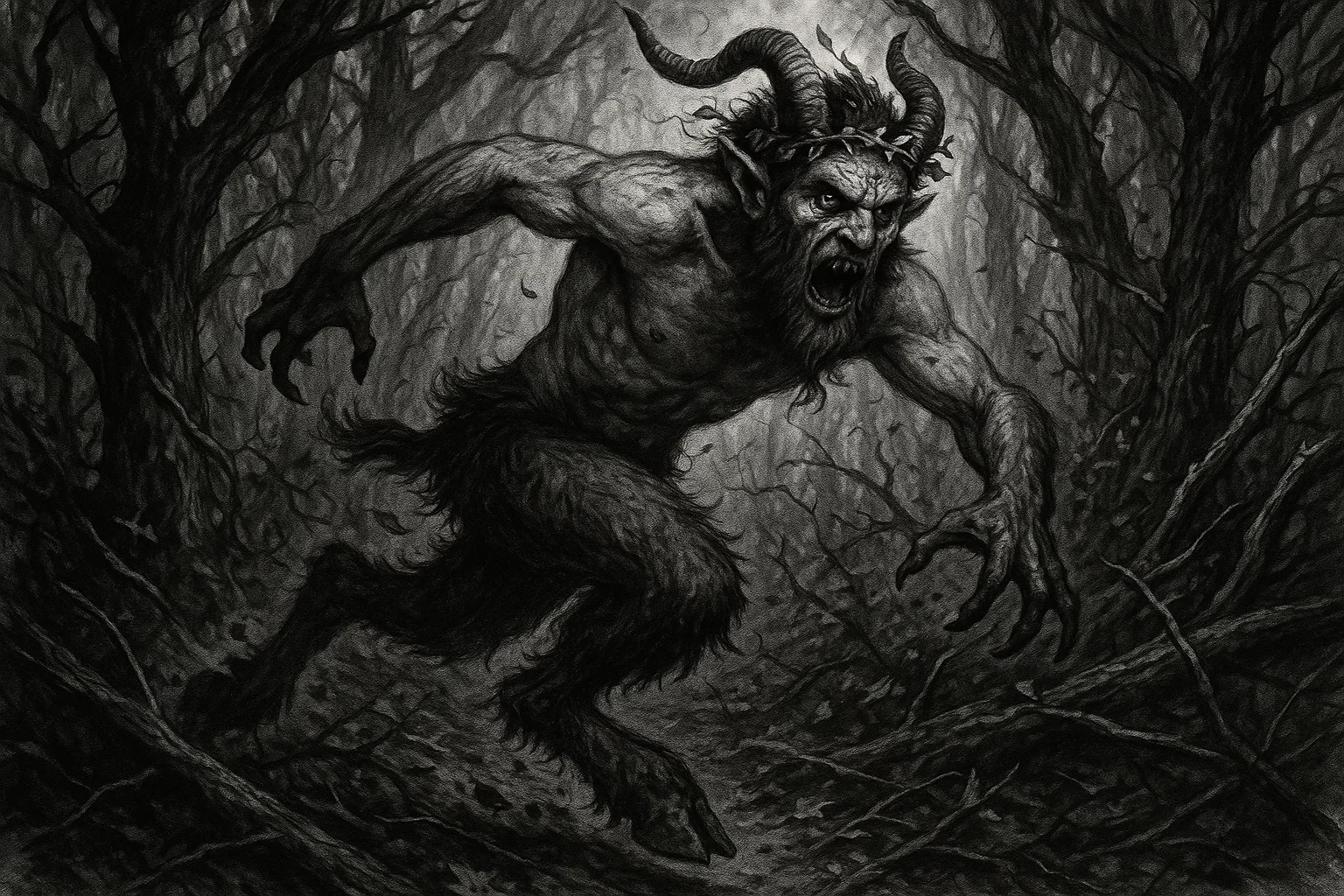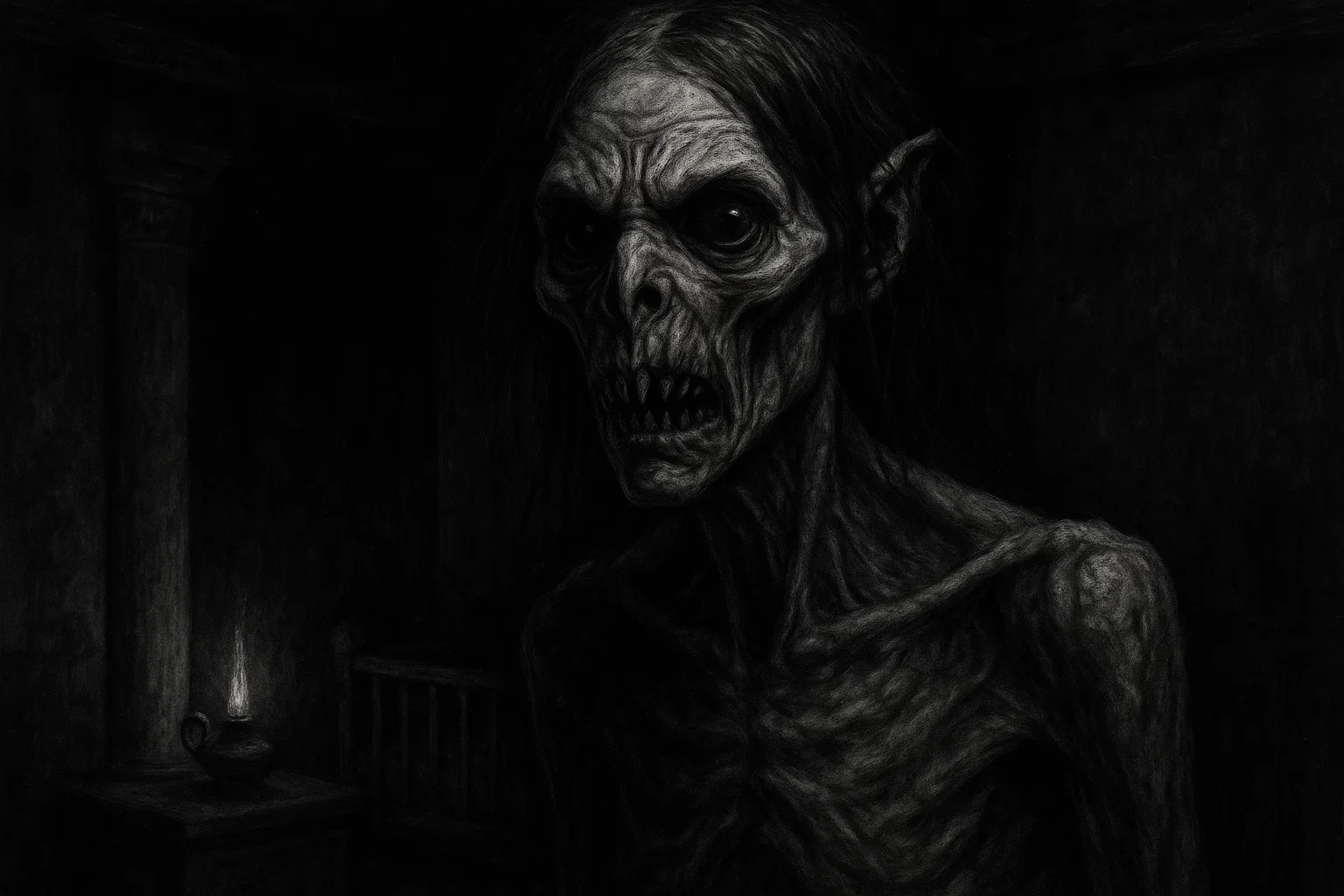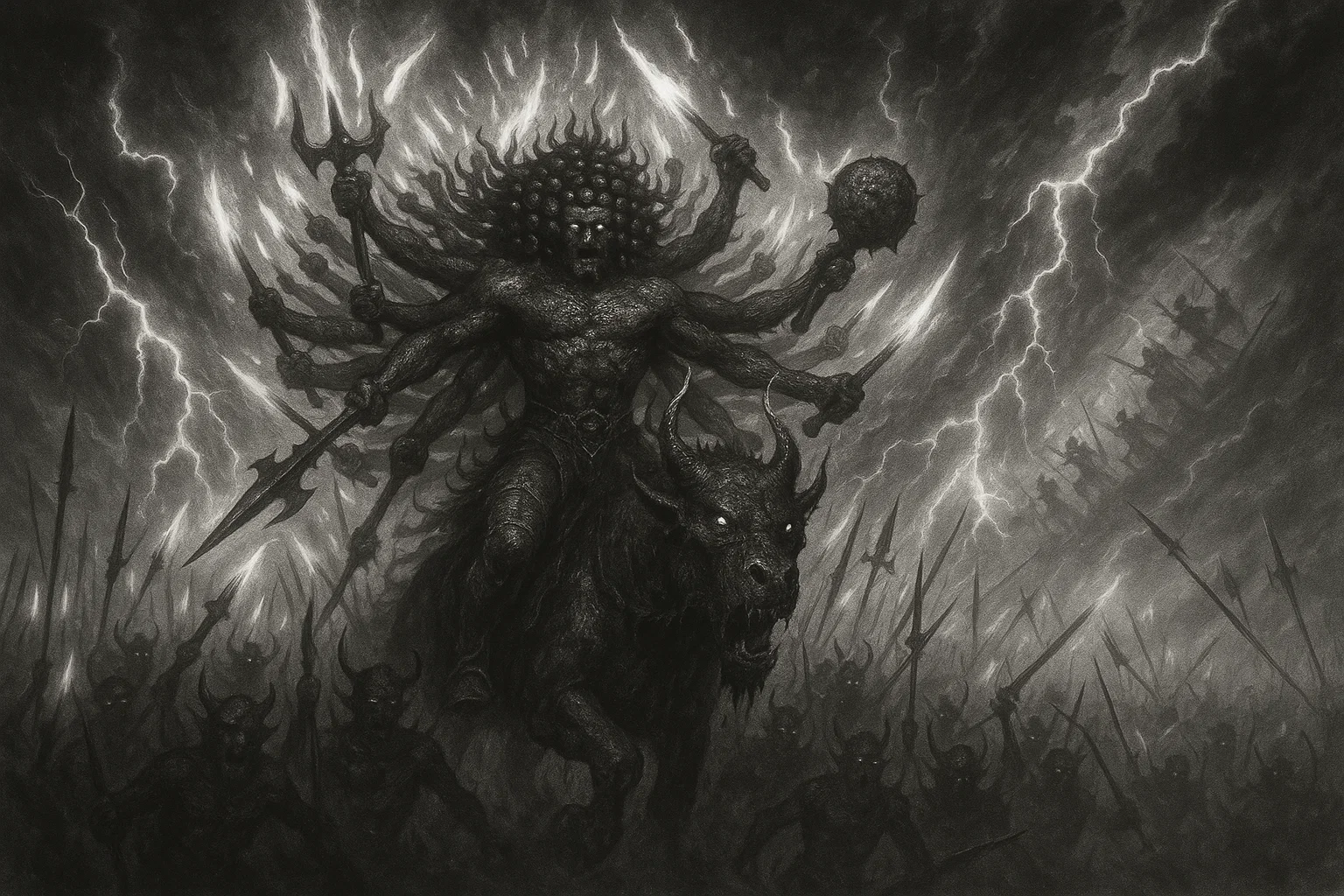The Pukwudgie is a small humanoid cryptid from the folklore of Algonquian-speaking tribes, particularly the Wampanoag. Standing two to three feet tall, it resembles a gray-skinned troll or goblin with enlarged features.
Once said to coexist peacefully with humans, Pukwudgies turned vengeful after perceived slights, leading to tales of trickery and harm.
Reports and alleged sightings still persist in forests across the northeastern United States, blending indigenous legend with modern sightings.
Summary
Overview
| Attribute | Details |
|---|---|
| Name | Pukwudgie |
| Aliases | Puckwudgie, Bagwajinini, Bokwjimen |
| Threat Level | Aggressive, capable of tricks, luring, or direct harm to humans |
| Habitat | Forests, swamps, and salt-water marshes in the northeastern United States, above 500 ft in altitude |
| Physical Traits | 2–3 ft (0.6–0.9 m) tall, gray smooth skin that may glow, enlarged noses, ears, and fingers; porcupine quills on the back in some accounts; humanoid with troll-like features |
| Reported Sightings | Freetown State Forest, Massachusetts; Mound State Park, Anderson, Indiana; Hockomock Swamp, Massachusetts; Round Rock, Texas; Moundsville State Penitentiary, West Virginia |
| First Documented Sighting | Early 20th-century folklore accounts; the earliest modern sighting in 1927 |
| Species Classification | Humanoid, unknown |
| Type | Terrestrial |
| Behavior & Traits | Mischievous tricks, shapeshifting into a porcupine or other forms, vanishing at will, nocturnal activity, luring victims to cliffs or swamps |
| Evidence | Eyewitness accounts, footprint casts, anecdotal reports of glowing figures |
| Possible Explanations | Misidentified porcupines, raccoons, or feral humans; cultural folklore misinterpretations |
| Status | Ongoing mystery with active modern reports |
Who or What Is a Pukwudgie?
The Pukwudgie originates in the oral traditions of Algonquian tribes, including the Wampanoag, Ojibwe, and Lenape. The term translates to “person of the wilderness” or “little wild man of the woods who vanishes.”
In these stories, Pukwudgies are magical beings created alongside humans. However, they grew resentful when humans favored the giant Maushop, a benevolent land spirit. This jealousy led them to oppose humanity, using powers like invisibility and illusion.
Pukwudgies function as tricksters in folklore, playing pranks or leading people astray. They possess the ability to shoot poison arrows, create fire, and summon spirits. Tribal elders advised avoiding the offending one, as offending them could result in curses or fatal encounters.
While rooted in pre-colonial narratives, the legend spread with European contact, influencing New England tales. Modern interpretations treat Pukwudgies as cryptids, with sightings reported in areas tied to indigenous lands.
You May Also Like: Bigfoot Sightings Across America: Full 50-State Guide
What Does the Pukwudgie Look Like?
Pukwudgies measure two to three feet tall, comparable to a young child but with adult human proportions scaled down.
Their skin appears smooth and gray, sometimes described as faintly glowing under moonlight. Enlarged noses, ears, and fingers distinguish their faces, which blend human and grotesque traits—often likened to a troll’s wrinkled features or a goblin’s sharp angles.
Hair, if present, grows coarse and dark, covering parts of the body. Some reports note quills or spines on the back, allowing the animal to transform into a porcupine-like form for defense or camouflage.
Eyes glow yellow or red in low light, aiding nocturnal hunts. Limbs are sturdy, supporting agile movement through underbrush. Clothing, when mentioned, consists of leaves or hides, though many sightings depict them nude.
These traits vary slightly by tribe: Wampanoag versions emphasize porcupine elements, while Ojibwe accounts highlight smoother, more ethereal builds.
Your Personalized, Hyper Accurate Moon & Astrology Reading
Limited time offer: Get your FREE, fully personalized Moon & Astrology Reading that takes astrology to a whole new level. Discover the secret depths of your personality, relationships, and true purpose in life.
Habitat
Pukwudgies inhabit dense forests and swamps across the northeastern United States, favoring areas with thick undergrowth and limited human intrusion.
Primary locations include the saltwater marshes around Popponesset Bay, south of Mashpee, Massachusetts, where Wampanoag lore places their origins.
Freetown State Forest in southeastern Massachusetts serves as a hotspot, encompassing 50 square miles of oak-hickory woods, ponds, and the enigmatic Hockomock Swamp—a 5,000-acre wetland known for its fog and diverse wildlife, including deer, foxes, and amphibians.
These environments feature temperate climates with humid summers and cold winters, supporting deciduous trees and ferns that provide cover. Elevations range from sea level to 500 feet, but Pukwudgies avoid open fields, preferring shadowed trails and bogs. Fauna includes porcupines and raccoons, animals often misidentified in sightings.
Human settlements border these zones, such as the town of Freetown, leading to legends of Pukwudgies luring intruders. Similar habitats extend to Indiana’s Mound State Park, with its ancient earthen mounds amid sycamore groves, and scattered reports from the Texas hill country.
Vegetation like cattails and sphagnum moss aids concealment, while seasonal flooding isolates areas, enhancing isolation. Tribal stories warn that entering these wilds without respect invites Pukwudgie interference, tying the creature to ecosystems symbolizing untamed nature.
Pukwudgie Sightings
| Date | Place | Witness Details | Description | Reliability |
|---|---|---|---|---|
| 1927 | Mound State Park, Anderson, Indiana | Paul Startzman, age 10 | Encountered a ‘little man’ with yellow hair on a trail | Medium: Single child witness, lifelong claims |
| 1960s | Freetown State Forest, Massachusetts | Local hikers and residents | Small gray figures lurking near trails, glowing eyes at night | Low: Anecdotal group reports, no physical evidence |
| 1976 | Hockomock Swamp, Bridgewater Triangle, Massachusetts | Multiple unnamed witnesses | Troll-like being with quills seen near water edges | Medium: Regional hotspot, consistent descriptions |
| 2006 | Crichton, Mobile, Alabama | Unnamed residents | Small goblin figure dubbed ‘Crichton Leprechaun’ | Low: Media sensationalism, single event |
| 2010s | Round Rock, Texas | Local Bigfoot hunters | 2-ft humanoid with gray skin in wooded areas | Low: Tied to broader cryptid hunts, vague details |
| 2016 | Freetown State Forest, Massachusetts | Woman named Joan | Humanoid with black matted fur and glowing eyes while walking dog at dawn | Medium: Detailed personal account, co-worker corroboration |
| 2023 | Freetown State Forest, Massachusetts | Hiker group | Small troll-like figure in underbrush, vanished quickly | Low: Group sighting, no photos |
| 2025 | Mounds State Park, Anderson, Indiana | Cryptid seekers | Goblin-like creatures near ancient mounds | Low: Recent enthusiast reports |
| 2025 | Freetown State Forest, Massachusetts | Hikers on June 16 | 2-3 ft troll-like figure lurking in underbrush | Medium: Multiple witnesses, timely report |
| Undated (Childhood) | Unnamed forest, Northeast US | Siblings sharing memory | Small hairy humanoid with glowing features | Low: Anecdotal family story |
| Undated | Moundsville State Penitentiary, West Virginia | Paranormal investigators | Gray glowing figures in haunted grounds | Low: Tied to ghost lore, no verification |
Paul Startzman (Mound State Park, 1927)
Paul Startzman, then a 10-year-old boy, reported his first encounter while hiking alone on a trail in Mound State Park, Indiana.
He described seeing a small figure about two feet tall with yellow hair, standing upright like a man. The being stared at him before vanishing into the brush.
Startzman, later an archaeologist, documented repeated sightings over decades, including groups of creatures similar to those near ancient Native American mounds. His accounts detailed their gray skin and quill-covered backs, linking them to Lenape legends.
Startzman’s persistence led to his book, The Pukwudjies of Indiana, in which he argued for their reality based on consistent patterns. Skeptics attribute early sightings to imagination, but his lifelong documentation lends them weight.
No photographs exist, but footprint casts from the 1970s showed small, clawed prints.
You May Also Like: Tahoe Tessie: The Mysterious Lake Monster of the Sierra Nevada
Joan (Freetown State Forest, 2016)
In the early morning hours between 4 and 5 a.m., Joan walked her dog through Freetown State Forest, Massachusetts. She spotted a humanoid figure roughly three feet tall with black, matted fur and piercing glowing eyes.
The creature stood motionless before emitting a low growl, prompting her dog to flee in terror. Joan retreated home, shaken, and shared the story with co-workers the next day. They identified it as a Pukwudgie, common in local lore.
Subsequent nights brought odd occurrences: rocks thrown at her window and unexplained fires near her property, ceasing after she left offerings of tobacco, a traditional appeasement. This encounter fits the pattern of anomalies in the Bridgewater Triangle.
Reliability originates from Joan’s detailed narrative in Christopher Balzano’s Dark Woods, though it lacks corroborating evidence.
Group Hikers (Freetown State Forest, 2023)
A group of hikers in Freetown State Forest reported a brief but vivid sighting of a troll-like figure in the underbrush.
Described as two feet tall with smooth gray skin and enlarged ears, it moved swiftly on all fours before standing bipedally and disappearing. The witnesses noted a foul odor and glowing yellow eyes.
One hiker captured blurry footage on a phone, showing a shadow but no clear form. Local rangers dismissed it as a raccoon, yet the group insisted on the humanoid shape.
This occurred near Profile Rock, a site tied to Wampanoag stories of Pukwudgie dwellings. Reports surged in the area that year, prompting warnings from tribal elders.
Awaken XT is unlike anything you’ve ever tried before…
…it’s based off a closely guarded formula that’s said to be able to supercharge your pineal gland and help you access your untapped inner power. With it’s unique blend of extremely hard to source ingredients, Awaken XT helps support the healthy functioning of your pineal gland, as well as your other organs in your body.
Hikers (Freetown State Forest, June 16, 2025)
On June 16, 2025, hikers in Freetown State Forest encountered a small, troll-like figure roughly two to three feet tall lurking in the underbrush.
The being had gray skin, quills protruding from its back, and red-glowing eyes. It emitted a high-pitched whistle before vanishing into foliage. The witnesses, experienced outdoorsmen, described a sense of being watched before the appearance.
One reported nausea afterward, a symptom in Pukwudgie lore attributed to their magic. This recent event, covered in local paranormal outlets, aligns with increased forest traffic. Multiple accounts from the day, including a second group hearing rustling, suggest activity.
Evidence & Investigations
Evidence for Pukwudgies remains anecdotal, centered on eyewitness reports rather than tangible artifacts. Footprint casts from Indiana’s Mound State Park in the 1970s show small, five-toed impressions with claw marks, measured at 4-6 inches long. These resemble porcupine tracks but include humanoid strides.
Audio recordings from Freetown State Forest capture high-pitched whistles and growls, which cryptozoologists analyze as non-animal in origin. Photographs are rare and blurry, such as a 2023 shadow image from hikers, dismissed by experts as pareidolia.
Scientific investigations are limited, as mainstream biology views Pukwudgies as folklore.
Cryptozoologist Loren Coleman explored the Bridgewater Triangle in the 1970s, documenting over 2,000 anomalies, including Pukwudgie-like figures. His book, Mysterious America, compiles sightings that suggest the existence of undiscovered primates.
In 2018, the Massachusetts Audubon Society surveyed Freetown Forest for small mammals, finding no matches but noting unexplained scat.
Amateur archaeologist Paul Startzman led informal expeditions in Indiana from 1927 onward, collecting quill samples he claimed were unnatural—later identified as porcupine. Paranormal groups like Spooky Southcoast use EMF detectors in hotspots, recording spikes during reported encounters.
Tribal studies by Wampanoag elders emphasize cultural context over proof, viewing Pukwudgies as spirits. A 2020 Lenape heritage project in Indiana interviewed descendants and correlated sightings with mound sites.
You May Also Like: What Is Átahsaia, the Cannibal Demon of Zuni Mythology?
Theories
Misidentified North American Porcupine
The porcupine theory posits that many Pukwudgie sightings stem from encounters with Erethizon dorsatum, the North American porcupine. This rodent reaches 2-3 feet in length, has black fur and quills, and is nocturnal, matching the descriptions.
When threatened, porcupines raise quills, resembling a “porcupine-man” from behind. Glowing eyes could result from eyeshine in flashlight beams, a trait absent in humans but present in rodents. Folklore’s shapeshifting element may arise from porcupines’ waddling gait, which makes them appear bipedal in dim light.
Biologists note that porcupines inhabit the same swamps and forests, with dense populations in Massachusetts. Startzman’s quill evidence aligns with this, as does the foul odor from musk glands.
Feral Human or Dwarfism Survivor
Some people suggest that Pukwudgies, the mysterious creatures of folklore, could actually represent humans with conditions like dwarfism who have survived in secluded forest areas. In 19th-century New England, there were stories of “wild children” — small, hairy individuals who seemed to grow up alongside animals.
One such condition, called primordial dwarfism, causes individuals to be under 3 feet tall and to have disproportionate growth. If these individuals lived alone in the woods, it could explain why they are so hard to find.
They might also have learned to use tricks to protect themselves from outsiders. Indigenous stories might contain memories of these outcasts, who were marginalized and later turned into legends.
Research on some Native American groups has found rare genetic traits related to height that potentially exist among small, hidden communities. Additionally, sightings near ancient burial mounds suggest that hermits may have once lived in those areas long before colonization.
This idea helps explain the Pukwudgies’ human-like qualities and intelligence. Still, it’s important to note that no skeletons or physical evidence have been found to support this theory.
Critics, however, argue that there have been no confirmed sightings of wild human populations in the areas studied.
Spiritual Entity from Algonquian Cosmology
This theory, rooted in Wampanoag beliefs, describes Pukwudgies as spirit beings that protect nature. According to tradition, they were created as guardians of the wilderness and represent life forces, known as manitou.
They can become hostile when people disrespect their environment. Pukwudgies are said to be able to change shape and disappear, reflecting the spiritual beliefs of their culture rather than any physical characteristics.
Elders in the community describe Pukwudgies as illusions or images triggered by actions such as littering in sacred places. After some recent incidents, tribal leaders suggested focusing on spiritual rituals instead of hunting these beings. This helps explain why there is often no concrete evidence of them; they seem to appear without leaving any traces.
There are similarities in other Native American stories, such as the Ojibwe tales of the windigo, which also speak of spirits that punish human greed.
While some skeptics argue that Pukwudgies are just products of the mind, the ongoing belief in them within indigenous cultures highlights their importance and validity in these traditions.
You May Also Like: What Are the Teihiihan—the Cannibal Dwarves of the Great Plains?
Undiscovered Primate Species
Some researchers who study mysterious creatures, known as cryptozoologists, believe that Pukwudgies might be a type of small human relative, similar to ancient species such as Homo floresiensis, adapted to live in North America’s forests.
These tiny beings are thought to be small enough to navigate through trees easily, and their gray skin may help them blend in with their surroundings, especially in mossy areas.
Pukwudgies might have enhanced senses that help them hunt in low light, and some suggest their quills could be for decoration or perhaps a sign of genetic changes over time. Fossil discoveries of small primates from a long time ago in areas around the Great Lakes support this idea.
Interestingly, sightings of Pukwudgies tend to occur in areas that haven’t been covered by glaciers, suggesting pockets where they’ve survived. In the 2010s, DNA tests of hair samples purportedly from Pukwudgies in Indiana showed markers that didn’t match those of known animals, suggesting they could be an undiscovered species.
Their behavior seems to resemble that of New World monkeys, particularly in how they use tools and communicate. Some expeditions, such as those led by researcher Loren Coleman, have even found bent branches that might serve as nests.
This scientific perspective challenges the idea that Pukwudgies exist only in folklore, despite no one ever having captured one alive. Estimates suggest that there are probably fewer than 100 of them, which helps explain why they are so rarely seen.
Comparison with Other Similar Cryptids
| Cryptid | Origin/Region | Key Traits | Behavior | Habitat |
|---|---|---|---|---|
| Duende | Latin America, Iberian folklore | Small humanoid with backward feet, pointed ears | Mischievous pranks, kidnapping children | Forests, homes |
| Troll | Scandinavian Europe | Gray stony skin, large nose, regenerative abilities | Hostile to humans, turns to stone in sunlight | Mountains, caves |
| Goblin | English/British folklore | Green or gray skin, sharp teeth, magical | Thievery, curses, nocturnal raids | Caves, ruins |
| Kobold | German folklore | Shapeshifting, household spirit form | Helpful or harmful based on treatment | Homes, mines |
| Brownies | Scottish folklore | Tanned skin, ragged clothes, elf-like | Aid in chores if unthanked, turns vengeful | Farms, households |
| Dwarf | Norse/Germanic mythology | Stocky build, long beards, craftsmanship | Skilled forgers, greedy hoarders | Underground halls |
| Kalanoro | Madagascar, Malagasy folklore | Backward feet, red eyes, fire-starting | Guardian of forests, attacks intruders | Rainforests |
| Alux | Mayan, Yucatan Mexico | Small Mayan-dressed figures, whistles | Protects land, causes illness if offended | Cornfields, cenotes |
| Chaneque | Aztec/Nahua, Mexico | Child-sized, spirit guardians | Lures wanderers, possesses souls | Jungles, rivers |
| Menehune | Hawaiian folklore | Dwarf builders, red hair | Constructs at night, elusive workers | Valleys, forests |
| Yunwi Tsunsdi | Cherokee, Southeastern US | Little people, invisible helpers | Teaches medicine, punishes laziness | Mountains, caves |
| Mikmaq Fairy | Mi’kmaq, Maritime Canada | Winged or wingless, nature spirits | Benevolent guides, forest protectors | Woodlands, shores |
You May Also Like: The Nimerigar: Cannibalistic Little People of the Rocky Mountains
Is the Pukwudgie Real?
Pukwudgies are mysterious little creatures that have been spotted for centuries. Stories about them can be traced back to the Algonquian Native American tribes, and reports of sightings have continued into 2025, especially in places like Freetown Forest.
People have found things like unusual footprints and strange sounds, leading some to believe that these sightings are more than just coincidences. However, many of the reported encounters can often be explained by things like mistaking porcupines for Pukwudgies or interpreting them through cultural beliefs.
Despite the lack of physical evidence, some tribes consider Pukwudgies to be important spirits that help maintain balance in nature. The legend of the Pukwudgie is a significant part of New England’s culture, influencing both education about indigenous peoples and tourism in the area.
While it seems likely that the Pukwudgie stories have grown through psychological and folkloric processes, there are still occasional reports that cannot be easily explained. Without concrete proof, Pukwudgies remain a fascinating mystery, reminding us to respect the wilderness they represent.

